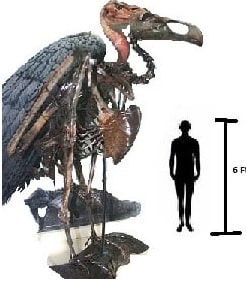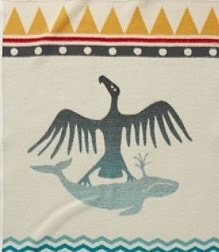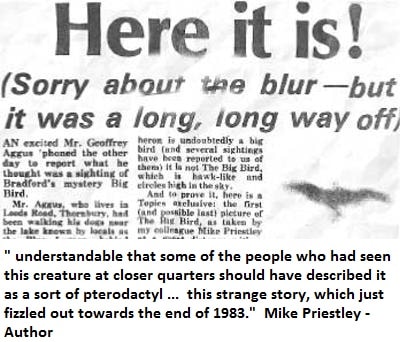Conventional scientific theory dictates that the dinosaurs have been extinct for about 65 Million years give or take a millennia or two. The fossil record seems to indicate a mass extinction that resulted from a global cataclysm around that period.
However, ancient and some not so ancient tales and artifacts lend credence to the argument that some of the dinosaurs did not so readily keel over and die off in the mass extinction. Some may have co-existed with Humans and our primitive ancestors for many many generations and some may have actually survived in an slightly evolved state till the current era.
The Tetratornis which was indigenous to the Western USA, unlike pterodactyl, and pterosaurs had feathers, it was/is very similar to modern day vultures, an extremely large version. Tetratornis is alleged to have gone extinct roughly 5 million years ago. However legends and contemporary sightings seem to indicate that this ancient leviathan, or a close cousin thereof survives to this day.
The creature is sometimes described as featherless and dragon-like, and more similar to the pterodactyl / pterosaurs, however most of the native legends and contemporary descriptions depict a feathered creature which could well be aggrandizing the tale to fit what they were most familiar with as a flying creature or could be more in line with the Tetratornis.
American Indian Thunderbird Legends
There are Native American Legends of flying beasts called the "thunderbird" which has come to be the generic English term . The Chippewa called it Binesi, the abenaki and micmaque of Newfoundland and Nova Scotia called it Badogiak and it hails by other names in the lore of various tribal groupings. Various tales expand on the story and assign supernatural characteristics to it, but the core of the legends are similar enough to assume it could be the same beast.
Many legends tell of the sound of thunder when its wings flaps which is understandable considering it is alleged to have a wingspan of up to 160 feet. Assuming that the tales, if they are true, are slightly aggrandized we can safely assume it still has quite an impressive wingspan - unlike that of any known bird.
The Last of the Thunderbirds
An Alaskan Eskimo Legend "The Last of the Thunderbirds" tells of a pair that preyed on the local populous.
LONG, long ago there were many thunderbirds living in the mountains, but at last there were only two left. These birds made their home on the round top of a mountain overlooking the Yukon.
xxx They hollowed out a great basin on the summit for a nest, and from the rocky rims they could look down upon a village upon the river bank.
From this perch the thunderbirds, looking like a black cloud, would soar away, bringing back to their young a reindeer in their talons. Sometimes with a great noise like thunder they swooped down upon a fisherman in his kayak and carried him away. The man would be eaten by the young birds, and the kayak broken to bits in the nest.
The story continues with a mighty hunter among the inuit climbing the mountain and killing off the nest of Thunderbirds. - Myths and Tales of Alaska pg. 98
As recently as 2002 a giant bird was spotted over Southwestern Alaska with a wingspan estimated at 14 feet. Thunderbirds: America's Living Legends of Giant Birds Pg. 11
Cherokee and Assorted Native Legends
The Cherokee legends tell of a giant man eating bird they called 'tlanuwa', this giant bird of prey, as per the folk lore, had impenetrable metallic feathers. The metallic aspect is mirrored in the 1976 sighting by John S. Carroll where he stated they were "steel grayish blue feathers" Most other tribes of the South and South West had similar shared stories of the giant man eaters.
Indians of the Pacific Northwest have tales of thunderbird that would carry off whales away into their Mountain nests. The Twana Indians who were in control of the Hood Canal Region to the end of the 1850s, said their hunters sometimes found nests of Thunderbirds in the mountains and they also found whale bones..... the Quinnault another tribe of the area had a story of a whale found thrashing about on a mountain with its dorsal fin missing.
Thunderbird Sightings 1800s to Present
When the white settlers began arriving in the West, during the days of Billy the Kid and Jesse James several photographs were taken which purport to show slain thunderbirds. Unfortunately many of the photographs floating around today are promotional pictures from a failed 1970s television show - ceist la vie .
In 1890 the Tombstone Epitah published an article that had all the hallmarks of the tall tales that were so commonly written in the era. ... "A winged monster, resembling a huge alligator with an extremely elongated tail and an immense pair of wings, was found on the desert between the Whetstone and Huachuca mountains last Sunday by two ranchers who were returning home from the Huachucas. The creature was evidently greatly exhausted by a long flight and when discovered was able to fly but a short distance at a time." See- Tombstones Flying Monster
Later that same year a California newspaper published a commentary on the tombstone article stating 'Such a bird, reptile or monster was seen about three years ago by three Mexican rancheros living near Elizabeth Lake.....this flying amphibious monster was seen several times from 1881 to 1886 in the Elizabeth Lake area of California.... was seen emerging and flying away eastward. '
A record of Thunderbird sightings form 1890 up to 1971 was assembled by Historian Robert Lyman Sr. Mothman and Other Curious Encounters pg. 80
It is alleged that in the 1920s, a man from Clarita, Oklahoma shot one down as it was preying on small children from the town. It bones are believed to be buried in a nearby creek bed.
1976 - for several weeks in December of 1976 a large bird was spotted by different people in the vicinity of Bethel Texas. A pig farmer known as John S. Carroll spotted the bird standing in a pond from a distance of less than 150 feet he observed a height of roughly 8 feet, a wingspan of about 12 feet, a neck of about 3 feet and the creature Caroll reported - unlike Pterodactyl was winged with steel grayish blue feathers. Thunderbirds: America's Living Legends of Giant Birds pg. 73
Halfway across the World in the isolated regions of the South Pacific, north of Australia and South of China lies New Guinea which is rife with reports of luminous nocturnal predatory flying creatures known locally as the "Kor" - While the North American creatures bare a resemblance to Teratornis, the south pacific Kor and similar but smaller hypothetical creatures known as the 'ropen' both bare striking resemblances to what science dictates the allegedly extinct species of Pterodactyl and pteosaur look[ed] like.
An American WWII pilot Duane Hodgkinson believes he saw one of these creatures in 1944 when he was stationed near New Guinea. Hodgkinson and a friend walked into a clearing, and spooked a very large creature that flew into the air. They quickly realized that it was no bird that they had ever seen or heard of as it circled the clearing. It had a tail ten to fifteen feet long, and a long appendage at the back of its head but of course we all know these creatures are extinct - right ? ... Maybe Not.
See: Living Pterosaurs



